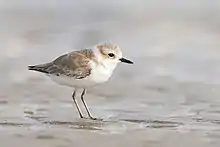White-faced plover
The white-faced plover (Charadrius dealbatus) is a small shorebird of the family Charadriidae. Initially described by British ornithologist Robert Swinhoe, the bird resembles the Kentish plover (Charadrius alexandrinus) with which it has been much confused[2] and sometimes considered to be a subspecies.[3]
| White-faced plover | |
|---|---|
 | |
| A white-faced plover in Laem Pak Bia, Thailand | |
| Scientific classification | |
| Kingdom: | Animalia |
| Phylum: | Chordata |
| Class: | Aves |
| Order: | Charadriiformes |
| Family: | Charadriidae |
| Genus: | Charadrius |
| Species: | C. dealbatus |
| Binomial name | |
| Charadrius dealbatus Swinhoe, 1870 | |
| Synonyms | |
| |
Taxonomy
The white-faced plover was first described in 1870 by the English biologist Robert Swinhoe. The type specimen came from the island of Formosa (Taiwan) and he gave it the name Aegialites dealbatus. Since then the bird has been the subject of much debate and has variously been classified as being conspecific with Charadrius marginatus, Charadrius alexandrinus, Charadrius nivosus, Charadrius javanicus and Charadrius ruficapillus. Some authors consider it to be a subspecies of C. alexandrinus while others give it full species status as C. dealbatus.[4]
Description
The white-faced plover grows to a length of about 17 cm (6.7 in). It has a rounded head with a white fore-crown and a white supercilium. The crown is pale rufous brown upper parts are pale brownish-grey. The hind collar, throat and underparts are white. The beak and legs are dark and the tail short. Compared to the rather similar Kentish plover, it has a thicker, blunter beak, white lores, paler crown and upperparts, less black on the lateral breast patches and a larger white wingbar.[4]
Distribution and habitat
This bird is found along a wide seaboard area of southern China and adjacent northern Vietnam ; its wintering range extends south across eastern Indochina towards Sumatra. It typically inhabits sandy beaches, mudflats and saltpans, and outside the breeding season visits reclaimed areas.[4]
Ecology
The diet of this bird has been little studied but is presumed to be similar to that of the Kentish plover which feeds on small invertebrates such as insects and their larvae, spiders, molluscs, crustaceans and marine worms. It feeds on the foreshore, searching visually for prey then dashing forward to catch the prey or probing the substrate with its beak.[5] Its breeding habits are not known.[4]
References
- BirdLife International (2016). "Charadrius dealbatus". IUCN Red List of Threatened Species. 2016: e.T22735615A95115530. Retrieved 19 January 2020.
- Kennerley, Peter R.; Bakewell, David N.; Round, Philip D. (2008). "Rediscovery of a long-lost Charadrius plover from South-East Asia" (PDF). Forktail. 24: 63–79.
- Rheindt, F. E.; Székely, T. S.; Edwards, S. V.; Lee, P. L. M.; Burke, T.; Kennerley, P. R.; Bakewell, D. N.; Alrashidi, M.; Kosztolányi, A. S.; Weston, M. A.; Liu, W. T.; Lei, W. P.; Shigeta, Y.; Javed, S.; Zefania, S.; Küpper, C. (2011). Steinke, Dirk (ed.). "Conflict between Genetic and Phenotypic Differentiation: The Evolutionary History of a 'Lost and Rediscovered' Shorebird". PLoS ONE. 6 (11): e26995. doi:10.1371/journal.pone.0026995. PMC 3212520. PMID 22096515.
- del Hoyo, J.; Collar, N.; Kirwan, G.M.; Sharpe, C.J. "White-faced Plover (Charadrius dealbatus)". Handbook of the Birds of the World Alive. Lynx Edicions, Barcelona. Retrieved 19 December 2019.
- Wiersma, P.; Kirwan, G.M.; Boesman, P. "Kentish Plover (Charadrius alexandrinus)". Handbook of the Birds of the World Alive. Lynx Edicions, Barcelona. Retrieved 19 December 2019.

